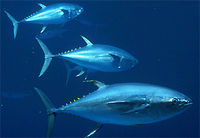Chordate
2007 Schools Wikipedia Selection. Related subjects: Insects, Reptiles and Fish
| iChordates |
||||||||||||
|---|---|---|---|---|---|---|---|---|---|---|---|---|
 Yellowfin tuna, Thunnus albacares
|
||||||||||||
| Scientific classification | ||||||||||||
|
||||||||||||
|
|
||||||||||||
|
See below |
Chordates ( phylum Chordata) are a group of animals that includes the vertebrates, together with several closely related invertebrates. They are united by having, at some time in their life, a notochord, a hollow dorsal nerve cord, pharyngeal slits, an endostyle, and a muscular tail extending past the anus. Some scientists argue that the true qualifier should be pharyngeal pouches rather than slits.
The phylum Chordata is broken down into three subphyla: Urochordata, Cephalochordata, and Vertebrata. Urochordate larvae have a notochord and a nerve cord but they are lost in adulthood. Cephalochordates have a notochord and a nerve cord but no vertebrae. In all vertebrates except for Hagfish, the dorsal hollow nerve cord has been surrounded with cartilaginous or bony vertebrae and the notochord generally reduced.
The chordates and two sister phyla, the hemichordates and the echinoderms, make up the deuterostomes, a superphylum.
The extant groups of chordates are related as shown in the phylogenetic tree below. Many of the taxa listed do not match traditional classes because several of those classes are paraphyletic. Different attempts to organize the profusion of chordate clades into a small number of groups, some with and some without paraphyletic taxa, have thrown vertebrate classification is in a state of flux. Also, the relationships of some chordate groups are not very well understood.
Classes of Chordata
In the subphylum Urochordata classes Ascidiacea, Thaliacea, Larvacea are found. Includes the sea squirts and tunicates.
In subphylum Cephalochordata, the worm-like lancelets are found.
In the subphylum Vertebrata (all animals with vertebrae) classes Myxini (hagfish), Conodonta, Hyperoartia (lampreys), Cephalaspidomorphi, Pteraspidomorphi, Placodermi, Chondrichthyes (sharks, rays and skates), Acanthodii (spiny sharks), Actinopterygii (ray-finned fish), Sarcopterygii (lobe-finned fish), Amphibia (amphibians), Sauropsida (reptiles), Synapsida, Aves (birds), and Mammalia (mammals) are found.
Classification
Taxonomy
- Phylum Chordata
- Subphylum Urochordata - Tunicates
- Subphylum Cephalochordata - Lancelets
- Class Myxini or Hyperotreti ( hagfish)
- Subphylum Vertebrata (Vertebrates - animals with backbones)
- Class Conodonta (Conodonts)
- Class Cephalaspidomorphi (jawless fish)
- Class Pteraspidomorphi (Paleozoic jawless fish)
- Infraphylum Gnathostomata ( jawed vertebrates)
- Class Placodermi (Paleozoic armoured forms)
- Class Chondrichthyes (cartilaginous fish)
- Class Acanthodii (Paleozoic "spiny sharks")
- Superclass Osteichthyes (bony fishes)
- Class Actinopterygii (ray-finned fish)
- Class Sarcopterygii (lobe-finned fish)
- Superclass Tetrapoda (four-legged vertebrates)
- Class Amphibia (amphibians)
- Series Amniota (amniotic egg)
- Class Synapsida (mammal-like "reptiles")
- Class Mammalia (mammals)
- Class Sauropsida - (reptiles)
- Class Aves (birds)
Phylogeny
Chordata
├─ Urochordata ( tunicates)
├─ Cephalochordata ( lancelets)
└ Craniata (animals with skulls)
├─ Myxini or Hyperotreti ( hagfish)
└ Vertebrata (animals with backbones)
├─ Conodonta (Conodonts)
├─ Cephalaspidomorphi (Paleozoic jawless fish)
├─ Hyperoartia ( lampreys and kin)
├─ Pteraspidomorphi (other Paleozoic jawless fish)
└ Gnathostomata ( jawed vertebrates)
├─ Placodermi (Paleozoic armoured forms)
├─ Chondrichthyes (cartilaginous fish)
└ Teleostomi (advanced fishes and their descendants)
├─ Acanthodii (Paleozoic "spiny sharks")
└─ Osteichthyes (bony fishes)
├─ Actinopterygii (ray-finned fish)
└─ Sarcopterygii (lobe-finned fish)
└ Tetrapoda (four-legged vertebrates)
├─ Lissamphibia (frogs and kin)
└ Amniota (amniotic egg)
├ Synapsida (mammals and kin)
└Sauropsida (reptiles and birds)
Note: Lines show probable evolutionary relationships (including extinct members of taxa)